Abstract
Energy balance, nitrogen balance, and growth studies were done in 37 preterm infants (20 of very low birthweight) who were fed on expressed breast milk or on one of 3 formulae each of different composition, including a special premature formula and a highly adapted 'humanised' formula. The variability of breast milk composition was such that it would have been difficult to predict the infants' protein and energy intakes under normal nursing conditions. All measured parameters of nutritional performance were best in infants fed on the 'premature' formula and were reflected in greater weight gain, linear growth, and head growth. The nitrogen balance data suggest that the highly adapted formula, which had a protein content comparable with that of mature human milk, contained too little protein for small preterm infants.
Full text
PDF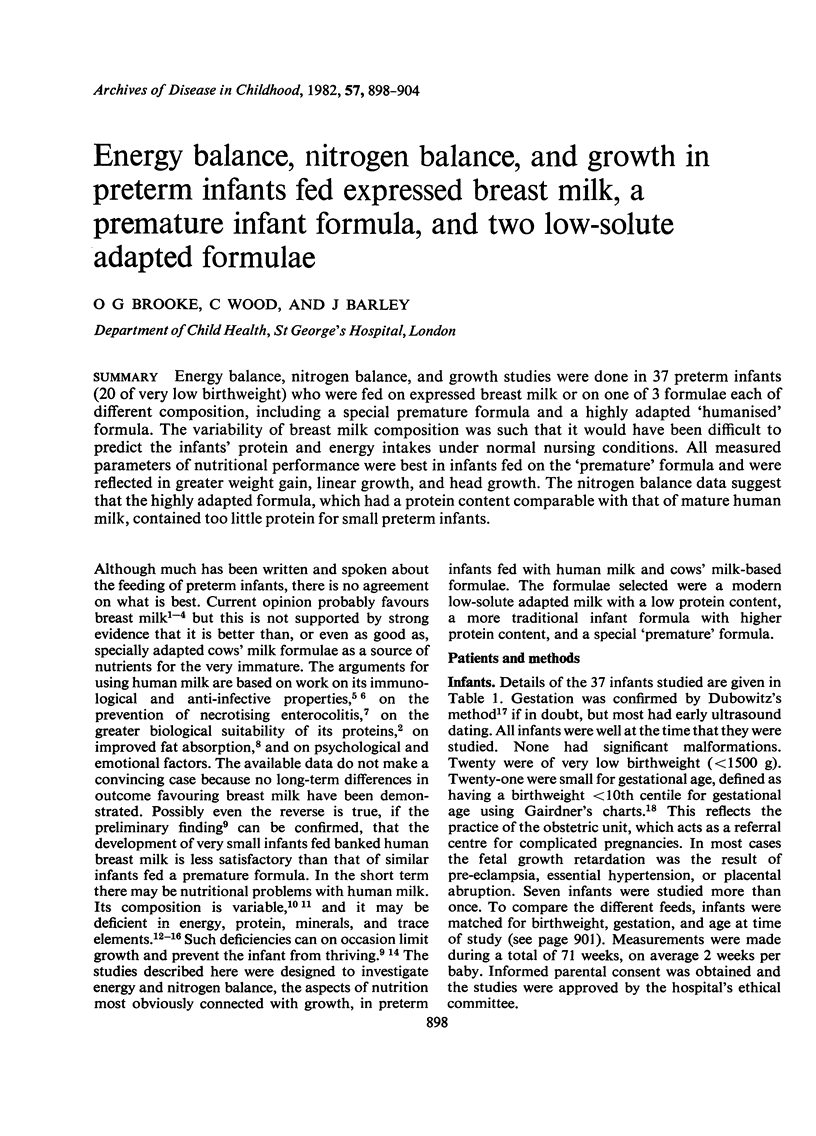
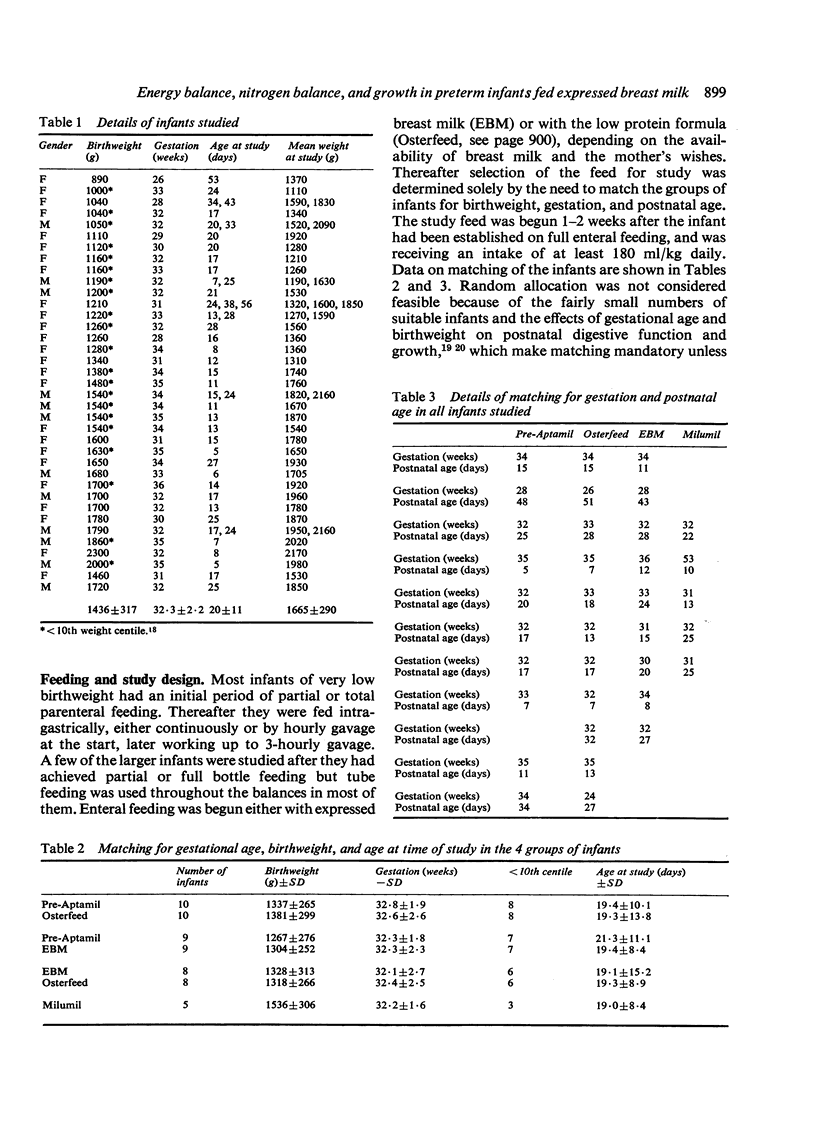
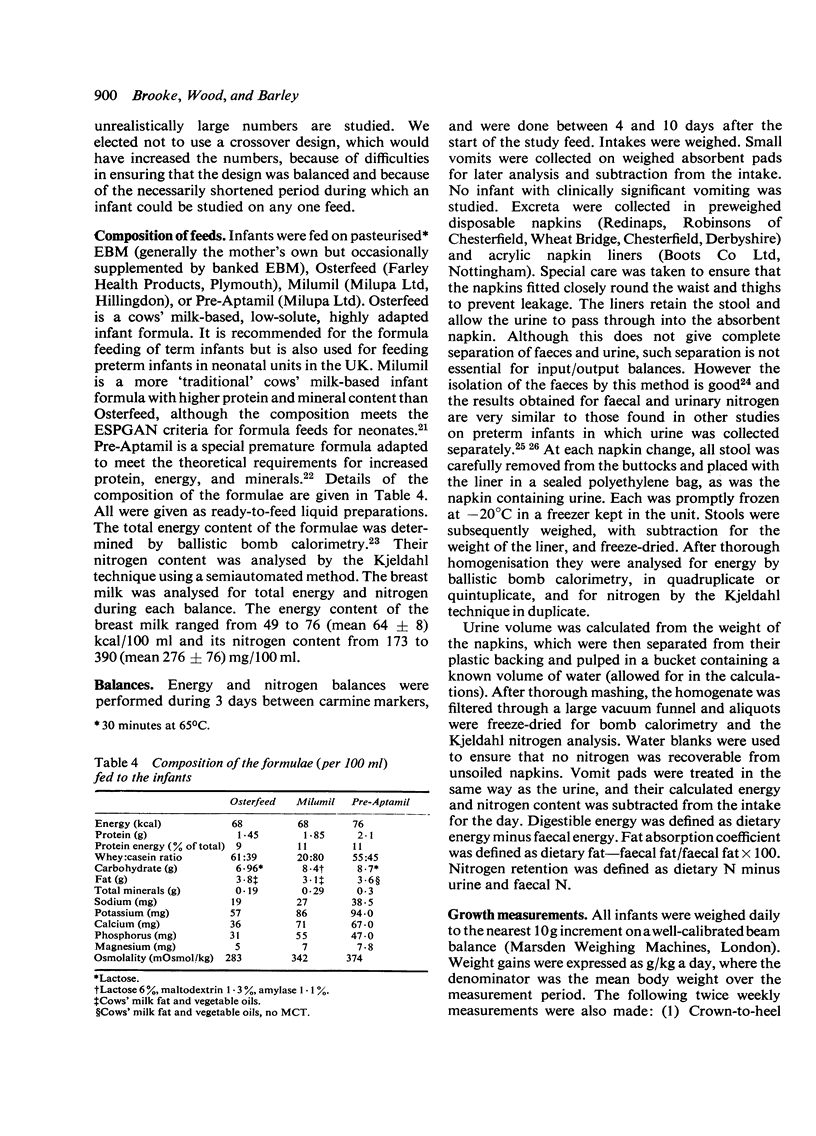

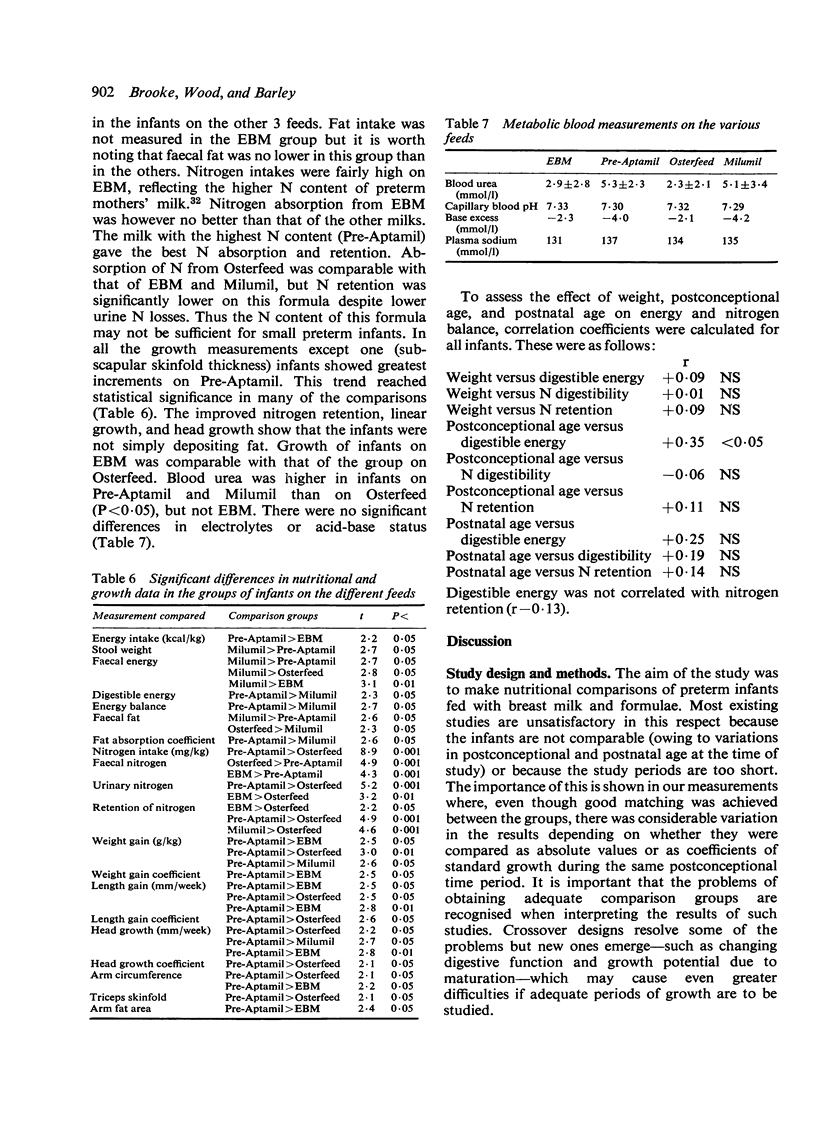
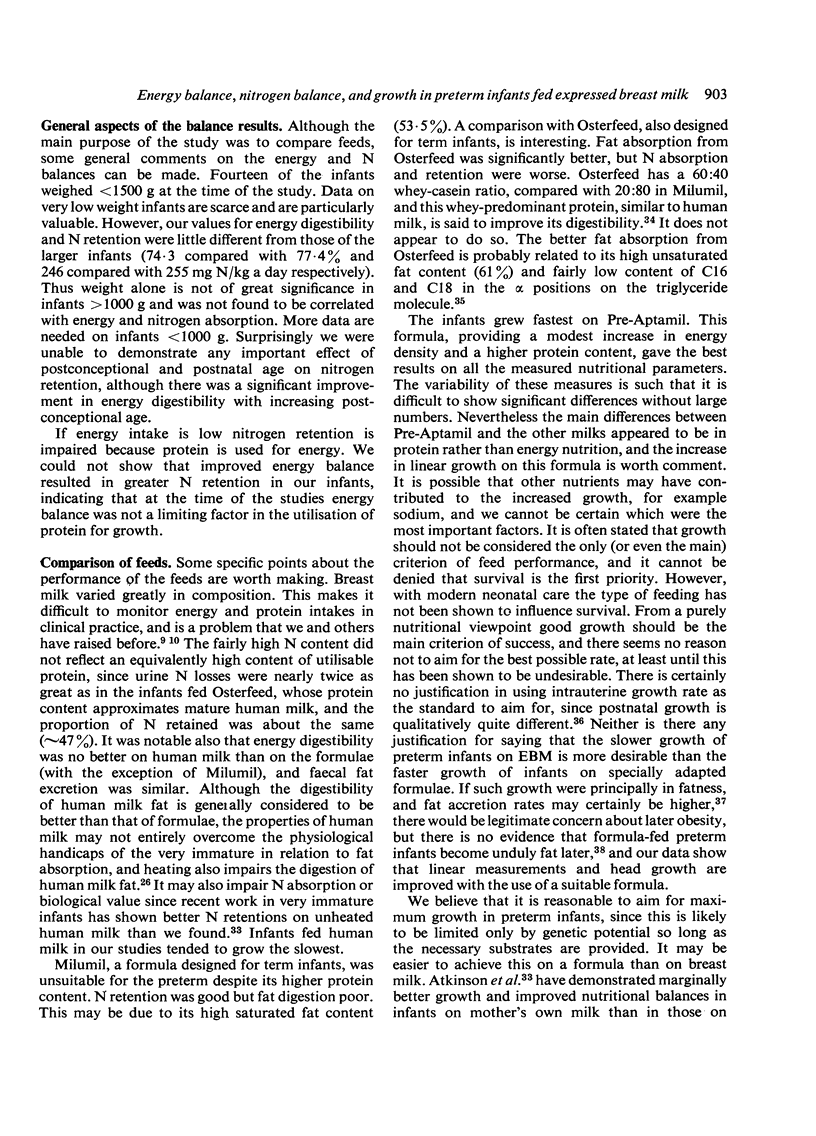

Selected References
These references are in PubMed. This may not be the complete list of references from this article.
- Addy D. P. Infant feeding: a current view. Br Med J. 1976 May 22;1(6020):1268–1271. doi: 10.1136/bmj.1.6020.1268. [DOI] [PMC free article] [PubMed] [Google Scholar]
- Atkinson S. A., Bryan M. H., Anderson G. H. Human milk feeding in premature infants: protein, fat, and carbohydrate balances in the first two weeks of life. J Pediatr. 1981 Oct;99(4):617–624. doi: 10.1016/s0022-3476(81)80275-2. [DOI] [PubMed] [Google Scholar]
- Atkinson S. A., Bryan M. H., Anderson G. H. Human milk: difference in nitrogen concentration in milk from mothers of term and premature infants. J Pediatr. 1978 Jul;93(1):67–69. doi: 10.1016/s0022-3476(78)80602-7. [DOI] [PubMed] [Google Scholar]
- Barlow B., Santulli T. V., Heird W. C., Pitt J., Blanc W. A., Schullinger J. N. An experimental study of acute neonatal enterocolitis--the importance of breast milk. J Pediatr Surg. 1974 Oct;9(5):587–595. doi: 10.1016/0022-3468(74)90093-1. [DOI] [PubMed] [Google Scholar]
- Brooke O. G., Butters F., Wood C., Bailey P., Tukmachi F. Size at birth from 37 - 41 weeks gestation: ethnic standards for British infants of both sexes. J Hum Nutr. 1981 Dec;35(6):415–430. [PubMed] [Google Scholar]
- Brooke O. G. Energy balance and metabolic rate in preterm infants fed with standard and high-energy formulas. Br J Nutr. 1980 Jul;44(1):13–23. doi: 10.1079/bjn19800005. [DOI] [PubMed] [Google Scholar]
- Davies D. P. Adequacy of expressed breast milk for early growth of preterm infants. Arch Dis Child. 1977 Apr;52(4):296–301. doi: 10.1136/adc.52.4.296. [DOI] [PMC free article] [PubMed] [Google Scholar]
- Dubowitz L. M., Dubowitz V., Goldberg C. Clinical assessment of gestational age in the newborn infant. J Pediatr. 1970 Jul;77(1):1–10. doi: 10.1016/s0022-3476(70)80038-5. [DOI] [PubMed] [Google Scholar]
- Filer L. J., Jr, Mattson F. H., Fomon S. J. Triglyceride configuration and fat absorption by the human infant. J Nutr. 1969 Nov;99(3):293–298. doi: 10.1093/jn/99.3.293. [DOI] [PubMed] [Google Scholar]
- Fomon S. J., Ziegler E. E., Vázquez H. D. Human milk and the small premature infant. Am J Dis Child. 1977 Apr;131(4):463–467. doi: 10.1001/archpedi.1977.02120170089018. [DOI] [PubMed] [Google Scholar]
- Gairdner D., Pearson J. A growth chart for premature and other infants. Arch Dis Child. 1971 Dec;46(250):783–787. doi: 10.1136/adc.46.250.783. [DOI] [PMC free article] [PubMed] [Google Scholar]
- Hanson L. A., Winberg J. Breast milk and defence against infection in the newborn. Arch Dis Child. 1972 Dec;47(256):845–848. doi: 10.1136/adc.47.256.845. [DOI] [PMC free article] [PubMed] [Google Scholar]
- Hibberd C. M., Brooke O. G., Brown I. R., Carter N. D., Wood C. A. Is preterm milk nutritionally advantageous? Am J Clin Nutr. 1981 Jun;34(6):1154–1155. doi: 10.1093/ajcn/34.6.1154. [DOI] [PubMed] [Google Scholar]
- Hibberd C., Brooke O. G., Carter N. D., Wood C. A comparison of protein concentrations and energy in breast milk from preterm and term mothers. J Hum Nutr. 1981 Jun;35(3):189–198. doi: 10.3109/09637488109143311. [DOI] [PubMed] [Google Scholar]
- Jackson A. A., Shaw J. C., Barber A., Golden M. H. Nitrogen metabolism in preterm infants fed human donor breast milk: the possible essentiality of glycine. Pediatr Res. 1981 Nov;15(11):1454–1461. doi: 10.1203/00006450-198111000-00014. [DOI] [PubMed] [Google Scholar]
- Jelliffe D. B. Unique properties of human milk (remarks on some recent developments). J Reprod Med. 1975 Apr;14(4):133–137. [PubMed] [Google Scholar]
- LUBCHENCO L. O., HANSMAN C., DRESSLER M., BOYD E. INTRAUTERINE GROWTH AS ESTIMATED FROM LIVEBORN BIRTH-WEIGHT DATA AT 24 TO 42 WEEKS OF GESTATION. Pediatrics. 1963 Nov;32:793–800. [PubMed] [Google Scholar]
- Lemoh J. N., Brooke O. G. Frequency and weight of normal stools in infancy. Arch Dis Child. 1979 Sep;54(9):719–720. doi: 10.1136/adc.54.9.719. [DOI] [PMC free article] [PubMed] [Google Scholar]
- Reichman B., Chessex P., Putet G., Verellen G., Smith J. M., Heim T., Swyer P. R. Diet, fat accretion, and growth in premature infants. N Engl J Med. 1981 Dec 17;305(25):1495–1500. doi: 10.1056/NEJM198112173052503. [DOI] [PubMed] [Google Scholar]
- Räihä N. C., Heinonen K., Rassin D. K., Gaull G. E. Milk protein quantity and quality in low-birthweight infants: I. Metabolic responses and effects on growth. Pediatrics. 1976 May;57(5):659–684. [PubMed] [Google Scholar]
- Schultz K., Soltész G., Mestyán J. The metabolic consequences of human milk and formula feeding in premature infants. Acta Paediatr Scand. 1980 Sep;69(5):647–652. doi: 10.1111/j.1651-2227.1980.tb07337.x. [DOI] [PubMed] [Google Scholar]
- Shaw J. C. Evidence for defective skeletal mineralization in low-birthweight infants: the absorption of calcium and fat. Pediatrics. 1976 Jan;57(1):16–25. [PubMed] [Google Scholar]
- TOMARELLI R. M., BERNHART F. W. Biological assay of milk and whey protein compositions for infant feeding. J Nutr. 1962 Sep;78:44–50. doi: 10.1093/jn/78.1.44. [DOI] [PubMed] [Google Scholar]
- Tanner J. M., Whitehouse R. H. Revised standards for triceps and subscapular skinfolds in British children. Arch Dis Child. 1975 Feb;50(2):142–145. doi: 10.1136/adc.50.2.142. [DOI] [PMC free article] [PubMed] [Google Scholar]
- Tanner J. M., Whitehouse R. H., Takaishi M. Standards from birth to maturity for height, weight, height velocity, and weight velocity: British children, 1965. I. Arch Dis Child. 1966 Oct;41(219):454–471. doi: 10.1136/adc.41.219.454. [DOI] [PMC free article] [PubMed] [Google Scholar]
- Watkins J. B. Mechanisms of fat absorption and the development of gastrointestinal function. Pediatr Clin North Am. 1975 Nov;22(4):721–730. doi: 10.1016/s0031-3955(16)33203-5. [DOI] [PubMed] [Google Scholar]
- Williamson S., Finucane E., Ellis H., Gamsu H. R. Effect of heat treatment of human milk on absorption of nitrogen, fat, sodium, calcium, and phosphorus by preterm infants. Arch Dis Child. 1978 Jul;53(7):555–563. doi: 10.1136/adc.53.7.555. [DOI] [PMC free article] [PubMed] [Google Scholar]
- Zimmerman A. W., Hambidge K. M., Lepow M. L., Greenberg R. D., Stover M. L., Casey C. E. Acrodermatitis in breast-fed premature infants: evidence for a defect of mammary zinc secretion. Pediatrics. 1982 Feb;69(2):176–183. [PubMed] [Google Scholar]


